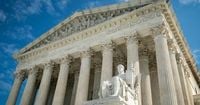On October 15, 2025, the U.S. Supreme Court will step into the heart of a decades-long battle over voting rights, hearing oral arguments in Louisiana v. Callais—a case with the potential to redefine the very foundation of America’s democracy. At stake is Section 2 of the Voting Rights Act, a key safeguard against racial discrimination in voting district maps, and possibly the future of fair representation for millions of Black, Latino, and other voters of color across the country.
The case, which has already drawn comparisons to watershed Supreme Court showdowns like Brown v. Board, Roe v. Wade, and Citizens United, began in the wake of the 2020 census. Louisiana’s legislature initially produced congressional maps with only one majority-Black district, despite the fact that Black voters make up roughly 30% of the state’s adult population. After a protracted legal fight and a federal court ruling, lawmakers were compelled to redraw the maps in 2024, this time establishing two majority-Black districts out of six—an attempt to more fairly reflect the state’s demographics and ensure Black communities could elect leaders of their choice.
But the new maps quickly became the center of controversy. A group of non-African American voters filed suit, arguing that the revised districts were unconstitutional because they relied too heavily on race. Their argument: that even considering race to remedy past discrimination violates the Equal Protection Clause of the 14th Amendment. So far, their challenge has not succeeded in lower courts, but now the nation’s highest court will have the final say.
“This is about more than lines on a map — it could decide whether millions of Black, Latino and other voters of color still have a voice in our representative democracy,” Lauren Groh-Wargo, CEO of Fair Fight Action, told CN. The stakes, she emphasized, are national, not just local.
The Supreme Court’s decision to rehear the case—delaying a ruling originally expected in June—has only heightened the drama. Rarely does the Court schedule reargument, and when it does, the results often reshape the legal landscape for generations.
At the heart of the debate is a familiar constitutional tension: Is using race to fix discrimination itself a form of discrimination? Chief Justice John Roberts, who has shaped the Court’s approach to race and equality over his two decades on the bench, famously wrote in 2013, “The way to stop discrimination on the basis of race is to stop discriminating on the basis of race.” This “colorblind” philosophy has become a guiding principle for the conservative majority, echoed in recent rulings that struck down affirmative action in college admissions.
Justice Clarence Thomas, a staunch supporter of the colorblind Constitution, previewed the conservative position in a recent dissent. “These cases put the court to a choice: It may permit patent racial gerrymandering under the auspices of Section 2 compliance, or it may admit that, as the court has construed the statute, a violation of Section 2 is insufficient to justify a race based remedy,” Thomas wrote, as reported by CN.
Yet, the Constitution’s 15th Amendment specifically addresses race, stating that voting rights cannot be denied based on “race, color, or previous condition of servitude.” Carolyn Shapiro, founder of the Institute on the Supreme Court at Chicago-Kent College of Law, argues that this language provides a firmer basis for considering race in voting rights cases than the 14th Amendment’s broader equal protection clause. “The 15th Amendment talks about race and is the only part of the Constitution that expressly talks about race,” she noted. “To my mind, the analysis of when race is appropriately considered under the 15th Amendment — including the originalist analysis — might be different from the colorblind approach that the current court is taking to the 14th Amendment.”
Liberal justices have pushed back hard against the notion that America has moved beyond the need for race-conscious remedies. Justice Sonia Sotomayor, dissenting in the affirmative action cases, wrote: “Brown recognized that passive race neutrality was inadequate to achieve the constitutional guarantee of racial equality in a nation where the effects of segregation persist. In a society where race continues to matter, there is no constitutional requirement that institutions attempting to remedy their legacies of racial exclusion must operate with a blindfold.”
Justice Ketanji Brown Jackson went further, criticizing what she called the majority’s “let-them-eat-cake obliviousness” and warning, “No one benefits from ignorance. Although formal racelinked legal barriers are gone, race still matters to the lived experiences of all Americans in innumerable ways, and today’s ruling makes things worse, not better. The best that can be said of the majority’s perspective is that it proceeds (ostrich-like) from the hope that preventing consideration of race will end racism.”
For civil rights advocates, the stakes could not be higher. As the National Women's Law Center pointed out, the Voting Rights Act has been transformative, especially for Black women, who have become one of the most influential voting blocs in the country since the law’s passage. The Act’s protections have led to greater political participation and representation, helping to secure victories not just for racial justice, but for gender justice and economic security as well.
“When the right to vote is under attack, our freedoms, protections, and security all hang in the balance,” the National Women's Law Center wrote in a recent analysis. The organization warned that undermining Section 2 would not only threaten racial and ethnic minorities’ access to the ballot box, but would also jeopardize hard-won rights for women, LGBTQIA+ people, and other marginalized groups who rely on fair representation to advance their interests in government.
Louisiana itself has shifted positions during the litigation. While the state initially defended the new maps, it later abandoned that stance, stating that there is “no safe harbor for racial discrimination.” Now, a group of voters continues to defend the maps, arguing that Section 2 only comes into play where racial discrimination is already present, and that a limited consideration of race is necessary to remedy that discrimination. “Congress ensured that Section 2’s results test is appropriately constrained and requires a remedy only where race is already shaping political decisionmaking,” they wrote in a court filing.
The potential consequences of the Supreme Court’s decision are enormous. According to a report from voting advocacy groups cited by CN, if the Court sides with the plaintiffs and strikes down Section 2, Republicans could gain an additional 19 safe seats in the U.S. House of Representatives, potentially cementing GOP control for a generation. “We’re watching the GOP advance to the endgame of a decades-long strategy to dismantle the Voting Rights Act and lock in their own power,” Groh-Wargo said. “If Section 2 is struck down, the court will be dragging us back to a pre-1965 America where racist maps blocked entire communities from having fair political representation.”
As the Supreme Court prepares to hear arguments, the nation is watching closely. The outcome could mark the end of an era for voting rights—and reshape the balance of power in America for years to come.


